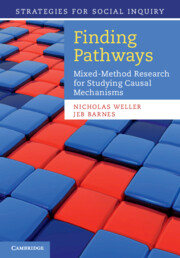Book contents
- Frontmatter
- Contents
- List of figures
- List of tables
- Acknowledgments
- 1 Pathway analysis and the elusive search for causal mechanisms
- 2 Preparing for pathway analysis
- 3 Case selection for pathway analysis
- 4 Comparison of case selection approaches
- 5 Regression-based case selection for pathway analysis of non-linear relationships
- 6 Matching to select cases for pathway analysis
- 7 Using large-N methods to gain perspective on prior case studies
- 8 Pathway analysis and future studies of mechanisms
- 9 Conclusion
- Glossary of terms
- References
- Index
5 - Regression-based case selection for pathway analysis of non-linear relationships
Published online by Cambridge University Press: 05 July 2014
- Frontmatter
- Contents
- List of figures
- List of tables
- Acknowledgments
- 1 Pathway analysis and the elusive search for causal mechanisms
- 2 Preparing for pathway analysis
- 3 Case selection for pathway analysis
- 4 Comparison of case selection approaches
- 5 Regression-based case selection for pathway analysis of non-linear relationships
- 6 Matching to select cases for pathway analysis
- 7 Using large-N methods to gain perspective on prior case studies
- 8 Pathway analysis and future studies of mechanisms
- 9 Conclusion
- Glossary of terms
- References
- Index
Summary
Introduction
In the last chapter, we applied our method to several simple textbook examples, including a hypothetical that posited a linear X1/Y relationship with equifinality (that is, multiple pathways between X1 and Y). In this chapter, we turn to a discussion of case selection in a more complex empirical setting: one that features a non-linear relationship between X1 and Y and the relationship is embedded in a longer causal chain that involves dynamic processes. Under these conditions, researchers must decide where in the causal process to investigate and how to deal with temporal dynamics in their large- and small-N studies. This chapter grapples with these issues by using an example drawn from the policy diffusion literature. As we make clear, in the context of pathway analysis, conceptualizing what is the key explanatory variable and what is the mechanism is not determined by the labels used in prior research or deep philosophical concerns, but rather by practical concerns regarding the relevant research question, how variables are used within the existing empirical research, and data availability. Once the relevant literature is properly understood, our method can be applied in a relatively straightforward manner.
International policy diffusion
The literature on international policy diffusion is both immense and contested. For purposes of this chapter, therefore, we distinguish between two very different types of studies. One type focuses on the threshold question of whether policy choices spread across political boundaries; that is, whether policy adoption is purely a function of domestic pressures (Berry and Berry 1990; Gray 1973, 1994; Simmons et al. 2008; cf. Volden et al. 2008). The second type of study essentially assumes that policies diffuse across borders, so its focus is on how and under what conditions policy decisions of one country spill over into others. In general, the literature that assumes the existence of diffusion and focuses on how policy diffusion works is more interesting for our purposes, as the search for mechanisms lies at its center (Simmons et al. 2008).
Information
- Type
- Chapter
- Information
- Finding PathwaysMixed-Method Research for Studying Causal Mechanisms, pp. 69 - 87Publisher: Cambridge University PressPrint publication year: 2014
